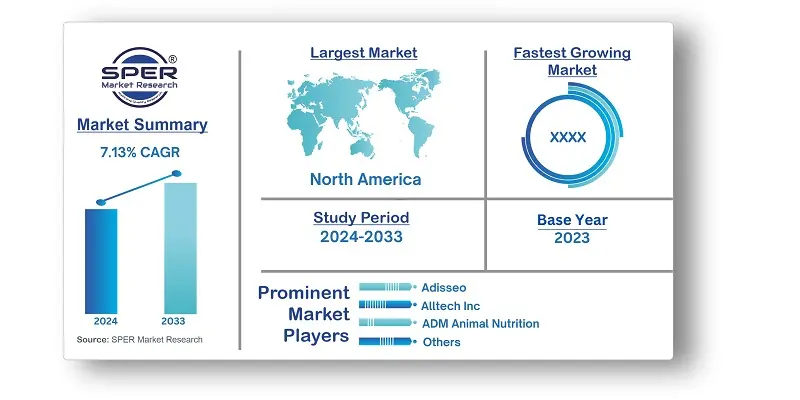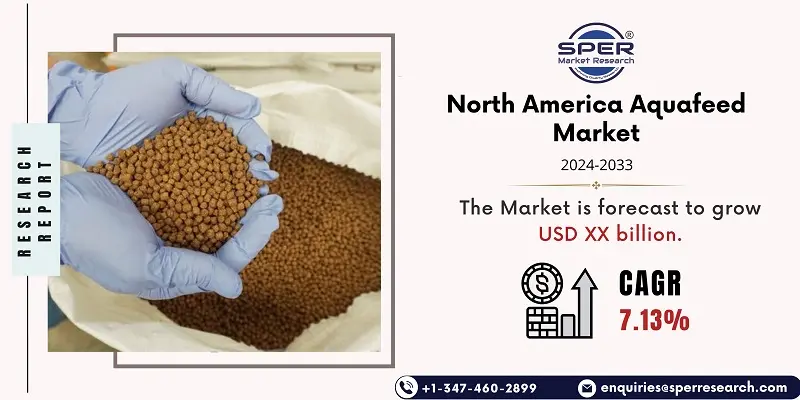
North America Aquafeed Market Growth, Size, Trends, Share, Demand, Revenue and Future Outlook
North America Aquafeed Market Size- By Species, By Ingredient, By Lifecycle- Regional Outlook, Competitive Strategies and Segment Forecast to 2033
| Published: Jun-2024 | Report ID: FOOD2464 | Pages: 1 - 156 | Formats*: |
| Category : Food & Beverages | |||
- October 2023; A new aquafeed based on algae was presented by Skretting. With the help of algae, this feed seeks to replace conventional fish oil and fishmeal, giving farmed fish a high-quality, sustainable nutritional substitute and lowering dependency on marine resources.
- April 2024; A new range of environmentally friendly aquafeed products developed by Bio Mar is designed to have a smaller environmental impact. In order to support environmentally friendly aquaculture methods, this line of feeds includes products that make use of creative ingredients and substitute protein sources.


| Report Metric | Details |
| Market size available for years | 2020-2033 |
| Base year considered | 2023 |
| Forecast period | 2024-2033 |
| Segments covered | By Species, By Ingredient, By Lifecycle |
| Regions covered | United States, Canada, Rest of North America |
| Companies Covered | Adisseo, Alltech Inc, ADM Animal Nutrition, Cargill Inc., Wilbur-Ellis Nutrition, LLC, Norel Animal Nutrition, Purina Animal Nutrition LLC. |
- Aquaculture Farmers
- Feed Manufacturers
- Distributors and Suppliers
- Research and Development Institutes
- Regulatory Bodies
- Investors and Stakeholders
| By Species: |
|
| By Ingredient: |
|
| By Lifecycle: |
|
- North America Aquafeed Market Size (FY’2024-FY’2033)
- Overview of North America Aquafeed Market
- Segmentation of North America Aquafeed Market By Species (Fish, Crustaceans, Mollusks)
- Segmentation of North America Aquafeed Market By Ingredient (Soybean, Corn, Fishmeal, Fish oil, Additives)
- Segmentation of North America Aquafeed Market By Lifecycle (Starter Feed, Grower Feed, Finisher Feed, Brooder Feed)
- Statistical Snap of North America Aquafeed Market
- Expansion Analysis of North America Aquafeed Market
- Problems and Obstacles in North America Aquafeed Market
- Competitive Landscape in the North America Aquafeed Market
- Impact of COVID-19 and Demonetization on North America Aquafeed Market
- Details on Current Investment in North America Aquafeed Market
- Competitive Analysis of North America Aquafeed Market
- Prominent Players in the North America Aquafeed Market
- SWOT Analysis of North America Aquafeed Market
- North America Aquafeed Market Future Outlook and Projections (FY’2024-FY’2033)
- Recommendations from Analyst
1.1. Scope of the report1.2. Market segment analysis
2.1. Research data source2.1.1. Secondary Data2.1.2. Primary Data2.1.3. SPER’s internal database2.1.4. Premium insight from KOL’s2.2. Market size estimation2.2.1. Top-down and Bottom-up approach2.3. Data triangulation
4.1. Driver, Restraint, Opportunity and Challenges analysis4.1.1. Drivers4.1.2. Restraints4.1.3. Opportunities4.1.4. Challenges4.2. COVID-19 Impacts of the North America Aquafeed Market.
5.1. SWOT Analysis5.1.1. Strengths5.1.2. Weaknesses5.1.3. Opportunities5.1.4. Threats5.2. PESTEL Analysis5.2.1. Political Landscape5.2.2. Economic Landscape5.2.3. Social Landscape5.2.4. Technological Landscape5.2.5. Environmental Landscape5.2.6. Legal Landscape5.3. PORTER’s Five Forces5.3.1. Bargaining power of suppliers5.3.2. Bargaining power of buyers5.3.3. Threat of Substitute5.3.4. Threat of new entrant5.3.5. Competitive rivalry5.4. Heat Map Analysis
6.1. North America Aquafeed Market Manufacturing Base Distribution, Sales Area, Product Type6.2. Mergers & Acquisitions, Partnerships, Product Launch, and Collaboration in North America Aquafeed Market
7.1. North America Aquafeed Market Size, Share and Forecast, By Species, 2020-20267.2. North America Aquafeed Market Size, Share and Forecast, By Species, 2027-20337.3. Fish7.4. Crustaceans7.5. Mollusks
8.1. North America Aquafeed Market Size, Share and Forecast, By Ingredient, 2020-20268.2. North America Aquafeed Market Size, Share and Forecast, By Ingredient, 2027-20338.3. Soybean8.4. Corn8.5. Fishmeal8.6. Fish oil8.7. Additives
9.1. North America Aquafeed Market Size, Share and Forecast, By Lifecycle, 2020-20269.2. North America Aquafeed Market Size, Share and Forecast, By Lifecycle, 2027-20339.3. Starter Feed9.4. Grower Feed9.5. Finisher Feed9.6. Brooder Feed
10.1. North America Aquafeed Market Size and Market Share
11.1. North America Aquafeed Market Size and Market Share By Region (2020-2026)11.2. North America Aquafeed Market Size and Market Share By Region (2027-2033)11.3. North America11.4. United States11.5. Canada11.6. Rest of North America
12.1. Adisseo12.1.1. Company details12.1.2. Financial outlook12.1.3. Product summary12.1.4. Recent developments12.2. Alltech Inc12.2.1. Company details12.2.2. Financial outlook12.2.3. Product summary12.2.4. Recent developments12.3. ADM Animal Nutrition12.3.1. Company details12.3.2. Financial outlook12.3.3. Product summary12.3.4. Recent developments12.4. Cargill Inc.12.4.1. Company details12.4.2. Financial outlook12.4.3. Product summary12.4.4. Recent developments12.5. Wilbur-Ellis Nutrition, LLC12.5.1. Company details12.5.2. Financial outlook12.5.3. Product summary12.5.4. Recent developments12.6. Norel Animal Nutrition12.6.1. Company details12.6.2. Financial outlook12.6.3. Product summary12.6.4. Recent developments12.7. Purina Animal Nutrition LLC.12.7.1. Company details12.7.2. Financial outlook12.7.3. Product summary12.7.4. Recent developments12.8. Others
SPER Market Research’s methodology uses great emphasis on primary research to ensure that the market intelligence insights are up to date, reliable and accurate. Primary interviews are done with players involved in each phase of a supply chain to analyze the market forecasting. The secondary research method is used to help you fully understand how the future markets and the spending patterns look likes.
The report is based on in-depth qualitative and quantitative analysis of the Product Market. The quantitative analysis involves the application of various projection and sampling techniques. The qualitative analysis involves primary interviews, surveys, and vendor briefings. The data gathered as a result of these processes are validated through experts opinion. Our research methodology entails an ideal mixture of primary and secondary initiatives.



Frequently Asked Questions About This Report
PLACE AN ORDER
Year End Discount
Sample Report
Pre-Purchase Inquiry
NEED CUSTOMIZATION?
Request CustomizationCALL OR EMAIL US
100% Secure Payment






Related Reports
Our Global Clients
Our data-driven insights have influenced the strategy of 200+ reputed companies across the globe.




















